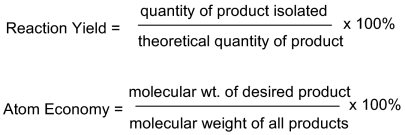Abstract
Green chemistry for chemical synthesis addresses our future challenges in working with chemical processes and products by inventing novel reactions that can maximize the desired products and minimize by-products, designing new synthetic schemes and apparati that can simplify operations in chemical productions, and seeking greener solvents that are inherently environmentally and ecologically benign.
Keywords: atom economy, synthetic efficiency, sustainable chemical feedstocks, green solvents
Over the past two centuries, fundamental theories and reactivities in chemistry have been soundly established. Such theories and reactivities have provided the foundations for the chemical enterprise that generates critical living needs such as food for the world's population, achieves various medical wonders that save millions of lives and improve people's health, and produces materials essential to the present and future needs of mankind. Just less than two centuries ago, organic compounds were believed to be only accessible through biological processes under the influence of “vital forces” (1). Today, many molecules of great complexity can be synthesized readily. The total syntheses of natural products with extremely high complexity such as vitamin B12 (2) and palytoxin (3) in the laboratory are testimonials of achievements comparable to the construction of the great pyramids at the molecular scale. However, despite such enormous achievements, we are facing great challenges in future chemical synthesis. The present state-of-the-art processes for synthesizing chemical products are highly inefficient. The concept of atom economy (4, 5) was created to emphasize the importance of this inefficiency. The E factor (6) provided a quantifiable measure of such inefficiency and showed that, for every kilogram of fine chemical and pharmaceutical products produced, 5–100 times that amount of chemical waste is generated. Such low efficiency in state-of-the-art organic syntheses presents great challenges in resource conservation and draws environmental and health concerns related to the chemical wastes.
Since its birth over a decade ago the field of Green Chemistry has been specifically designed to meet such challenges in chemical synthesis (7, 8). To address these challenges, innovative and fundamentally novel chemistry is needed throughout the synthetic processes: feedstocks, reactions, solvents, and separations.
Chemical Feedstocks
Presently, the main feedstock of chemical products comes from nonrenewable petroleum that is being depleted rapidly both for chemical and energy needs. However, nature provides a vast amount of biomass in the renewable forms of carbohydrates, amino acids, and triglcerides to obtain organic products (9), but a major obstacle to using renewable biomass as feedstock is the need for novel chemistry to transform the large amounts of biomass selectively and efficiently, in its natural state, without extensive functionalization, defunctionalization, or protection.
Reactions
Reactions play the most fundamental role in synthesis. The ideology of Green Chemistry calls for the development of new chemical reactivities and reaction conditions that can potentially provide benefits for chemical syntheses in terms of resource and energy efficiency, product selectivity, operational simplicity, and health and environmental safety.
Atom Economy.
Conventionally, attaining the highest yield and product selectivity were the governing factors of chemical synthesis. Little consideration was given to the usage of multiple reagents in stoichiometric quantities, which often were not incorporated into the target molecule and would result in significant side products. However, in a balanced chemical reaction, a simple addition or cyclo addition incorporates all atoms of the starting materials into the final product. Recognizing this fundamental phenomenon, in 1991 (4) Trost presented a set of coherent guiding principles for evaluating the efficiency of specific chemical processes, termed the atom economy, which has subsequently been incorporated into the “Twelve Principles of Green Chemistry” and has altered the way many chemists design and plan their syntheses. Atom economy seeks to maximize the incorporation of the starting materials into the final product of any given reaction. The additional corollary is that, if maximum incorporation cannot be achieved, then ideally the quantities of side products should be minute and environmentally innocuous. There is a fundamental difference in the manner in which a reaction yield and the atom economy yield is calculated (Fig. 1).
Fig. 1.
Definition of the fundamental difference in the manner in which the reaction and the atom economy yields are generated.
The reaction yield is only concerned with the quantity of the desired product that is isolated, relative to the theoretical quantity of the product. Atom economy takes all used reagents and unwanted side products into account along with the desired product. For example, substitutions and eliminations represent the vast majority of uneconomical classical reactions in which inherent wastes are unavoidable (Scheme 1). Simple additions or cycloadditions and rearrangements represent desired modes of reactivities (Scheme 1). Reaction Mass Efficiency (RME) and Mass Intensity (MI) are additional concepts to evaluate the efficiency of synthetic reactions to take into account the reaction yield (10).
Scheme 1.
Recently, innovative reactions with such inherent advantages have been developed with the aid of chemical and biological catalysts. Some representative examples are the following.
Isomerizations.
Isomerization of propargyl alcohols into conjugated carbonyl compounds provides an atom-economic means for synthesizing such compounds. By using a ruthenium-catalyzed redox isomerization of propargyl alcohols into enones in lieu of the traditional two-step stoichiometric reduction and oxidation sequence, a catalytic enantioselective total synthesis of adociacetylene B can be realized efficiently (Scheme 2) (11). Isomerization of an alkynyl vinylcyclopropene to a fused 5- to 7-ring structure converts classical atom inefficient synthetic strategies to ones of ideal atom economy (Scheme 3) (12).
Scheme 2.
Scheme 3.
Ring-opening metathesis polymerization.
The living ring-opening metathesis polymerization developed by Grubbs and coworkers represents another type of isomerization and has been used to make a variety of materials, such as those used in dentistry (Scheme 4) (13).
Scheme 4.
Addition reactions.
The processes of adding allyl alcohol to alkynes to form γ,δ-unstaturated ketones and aldehydes in aqueous media were developed by Trost et al. (14) and Dixneuf et al. (15), respectively (Scheme 5). Another elegant example was recently reported by Krische and coworkers (16), in which primary alcohols were added stereoselectively to alkenes, which provides an atom-economic version of the classical reaction where a Grignard reagent is added to an aldehyde (Scheme 6).
Scheme 5.
Scheme 6.
Direct Conversion of C–H Bonds.
Direct transformation of the C–H bonds of organic molecules into desired structures without extra chemical transformations represents another class of major desirable reactions (17–23). In nature, a variety of organic compounds can be oxidized easily by molecular oxygen or other oxygen donors in the cells of bacteria, fungi, plants, insects, fish, and mammals (24–26). It is worth noting the important advances in biomimetic approaches to such oxidations (27–36). Hydroxylation of linear alkanes or methane to generate terminal alcohols is very useful in the synthesis of chemicals and fuels (37).
However, the direct conversion of C–H bonds into C–C bonds leads to more efficient syntheses of complex products with reduced synthetic operations (38). Recently, great progress has been made in transition-metal-catalyzed activation and further reaction of C–H bonds (39). Li (40) and others have developed various methods to generate C–C bonds directly from two different C–H bonds in the presence of an oxidizing reagent through a cross-dehydrogenative coupling (CDC) catalyzed by transition metals. For example, (NH)-indoles and tetrahydroisoquinolines were converted directly into alkaloids by using such a coupling (Scheme 7) (41).
Scheme 7.
CDC reactions of various indoles with tetrahydroisoquinolines.
Recently, an elegant cross-coupling of two aryl C–H bonds to form arene–arene coupling products was reported by Fagnou, Sanford, and others (Scheme 8) (42, 43).
Scheme 8.
Synthesis Without Protections.
Because of the nature of classical chemical reactivity, organic synthesis extensively utilizes protection–deprotection of functional groups, which increases the number of steps in synthesizing the desired target compounds. Novel chemistry is needed to perform organic synthesis without protection and deprotection. Recently, progress has been made on this subject. For example, Baran et al. (44) have reported a total synthesis of a natural product without any protecting groups. Another instance is the efficient synthesis of (+)-3-deoxy-d-glycero-d-galacto-nonulosonic acid (KDN) by using the indium-mediated allylation reaction in water reported by Chan and Li (Scheme 9) (45).
Scheme 9.
The Knoevenagel condensation of the β-diketone with hemiacetalic sugar gave β-C-glucosidic ketone in water directly (Scheme 10) (46).
Scheme 10.
One step synthesis of β-C-glucosidic ketone in aqueous medium.
The Click chemistry (47) developed by Sharpless tolerates a wide range of functionalities and allows the direct modification of biological compounds. The archetypical example of Click chemistry is the Huisgen 1,3-dipolar cycloaddition of alkynes to azides to form 1,4-disubsituted 1,2,3-triazoles catalyzed by Cu(I) (Scheme 11). The reaction is mild and highly efficient, and does not require protecting groups.
Scheme 11.
Tandem/Cascade/Flow Reactors.
Also of fundamental importance to greener syntheses is the development of tandem and cascade reaction processes that incorporate as many reactions as possible to give the final product in one operation. For example, a palladium-catalyzed tandem reaction resulted in multirings in one step (Scheme 12) (48). Another example is Jamison's synthesis of the core piece of “ladder” polyether marine natural products through a biomimetic cascade cyclization in neutral water (Scheme 13) (49).
Scheme 12.
Scheme 13.
An alternative way to simplify organic syntheses into a single operation is to perform sequential reactions in a flow reactor. Ley and colleaques (50) reported that a multistep synthesis of the alkaloid natural product (±)-oxomaritidine can be accomplished by using microfluidic pumping systems that pass material through various packed columns containing immobilized reagents, catalysts, scavengers, or catch-and-release agents, combining seven separate synthetic steps linked into one continuous sequence (Scheme 14).
Scheme 14.
Synthesis in flow of (±)-oxomaritidine.
Biocatalysis.
Through millions of years of evolution and “sustainability,” nature developed highly efficient and selective means to achieve the desired transformations. The potential usefulness of various catalysts of Nature, such as enzymes (51), whole cells, and catalytic antibodies (52) for organic synthesis, has become more and more recognized. Frequently, biocatalysis leads to extremely high reaction rates and selectivities such as enantioselectivities that go beyond the reach of chemical catalysts. These developments have provided powerful and parallel tools in the synthetic chemist's toolbox. However, the high substrate specificity of enzymes presents a dilemma for synthetic chemistry in which wide substrate applicability is desired. The recent exciting development in “directed evolution” (53) provides potential opportunities in using biological catalysts to overcome this issue.
Solvents
Solvents are auxiliary materials used in chemical synthesis. They are not an integral part of the compounds undergoing reaction, yet they play an important role in chemical production and synthesis. By far, the largest amount of “auxiliary waste” in most chemical productions is associated with solvent usage. In a classical chemical process, solvents are used extensively for dissolving reactants, extracting and washing products, separating mixtures, cleaning reaction apparati, and dispersing products for practical applications. Although the invention of various exotic organic solvents has resulted in some remarkable advances in chemistry, the legacy of such solvents has led to various environmental and health concerns. Consequently, as part of Green Chemistry efforts, various cleaner solvents have been evaluated as replacements (54).
The primary function of solvents in classical chemical syntheses is to facilitate mass transfer to modulate chemical reactions in terms of reaction rate, yields, conversions, and selectivity. They do this by dissolving the reactants in dilute homogeneous mixtures. The ironic aspect of this process is that, after the reaction, the final product has to be reseparated from the solvent through energy-intensive means.
The development of Green Chemistry redefines the role of a solvent: An ideal solvent facilitates the mass transfer but does not dissolve! In addition, a desirable green solvent should be natural, nontoxic, cheap, and readily available. More desirably, it should have additional benefits of aiding the reaction, separation, or catalyst recycling. The concept of organic reactions “on-water,” (55) in which non-water-soluble reagents react by floating on water to generate a non-water-soluble and readily separable final product, is an excellent manifestation of this new definition.
Water.
The only natural solvent on earth is water. Life requires the construction of chemical bonds in an aqueous environment. It is obvious that water is the most inexpensive and environmentally benign solvent. Since it was reported that Diels–Alder reactions (56) could be greatly accelerated by using water as a solvent instead of organic solvents (Scheme 15), there has been considerable attention dedicated to the development of organic reactions in water (57–59). Besides Diels–Alder reactions, other examples cover almost all of the most useful organic reactions, even “water-sensitive” reactions (Scheme 16) (60). In many cases, because of hydrophobic effects, using water as a solvent not only accelerates reaction rates but also enhances reaction selectivities, even when the reactants are sparingly soluble or insoluble in the medium. Furthermore, the low solubility of oxygen gas in water, an important property in the early development of life in an anaerobic environment, can facilitate air-sensitive transition-metal catalysis in open air (61). The use of water as a solvent also implies the elimination of tedious protection–deprotection processes for certain acidic-hydrogen-containing functional groups, which contributes to the overall synthetic efficiency. Water-soluble compounds, such as carbohydrates, can be used directly without the need for laborious derivatization and water-soluble catalysts can be reused after separation from water-insoluble organic products. Aqueous organic chemistry is also essential in the emerging field of chemical biology, which uses chemical tools to study biological systems.
Scheme 15.
Scheme 16.
One challenge of using water as a solvent is the regeneration of pure water that contains only minor impurities. In this respect, newer purification technologies such as ultrafiltration or natural evaporation (if the impurity is not vaporizable) help. Another challenge of using water is separating water-soluble products from water. In addition, many organic compounds are not soluble in water. Although “on-water” techniques have provided excellent solutions for some situations, there will be cases where completely soluble in water is desired.
CO2.
In some cases, water is undesirable. Although some chemical processes may be modified to use water, green solvents with different properties than water are nevertheless needed. One such solvent is liquid and supercritical CO2. It is also a natural solvent, although some energy (pressure) is consumed in its production. In addition, CO2 is renewable, nonflammable, and readily evaporating. Other excellent features of CO2 include its fast drying time, better ability to dissolve organic compounds, and better flow ability because of its low viscosity compared with other solvents including water. These properties are complementary to water and provide supplementary needs. Through the landmark work by Noyori et al. (62), DeSimone et al. (63), Tumas and colleaques (64), Leitner (65), and others, supercritical CO2 is emerging as an important medium for chemical synthesis. One special feature of liquid and supercritical CO2 is its high mixibility with gases, which offers high efficiency (and often higher selectivity) in reactions such as hydrogenations with hydrogen gas and oxidations with air (66). Another feature of CO2 is its rapid separation from catalysts and products by simple depressurization and recapture. Taking the advantage of these features, Britz et al. (67) (Scheme 17) and Cole-Hamilton et al. (68) developed an efficient flow chemical reactor for clean synthesis (Fig. 2).
Scheme 17.
Fig. 2.
Continuous supercritical hydrogenation. [Figure reproduced courtesy of Martyn Poliakoff (Copyright held by Nottingham University).]
Nonnatural Solvents.
In addition to the two “natural green solvents”, various nonnatural ones have also been intensively studied as green alternatives. The most widely studied ones are ionic liquids (69). The greatest advantage of these solvents is their low vapor pressures, which offer advantages in reducing volatile organics in the air. Such novel solvents also offer various interesting new chemistries such as dissolving cellulose (70) and changing the outcome of reactions (71). Another innovative discovery is the recently developed “switchable solvents” by Jessop, Liotta, Erckert, and others (72). Such solvents change their properties with different needs. Beside these solvents, other synthetic solvents such as fluorous (73, 74) and property-changing soluble polymer systems (75) have been evaluated as potential green alternatives.
Conclusion
Our future challenges in resource, environmental, economical, and societal sustainability demand more efficient and benign scientific technologies for working with chemical processes and products. Green chemistry addresses such challenges by inventing novel reactions that can maximize the desired products and minimize by-products, designing new synthetic schemes and apparati that can simplify operations in chemical productions, and seeking greener solvents that are inherently environmentally and ecologically benign. Together, such fundamental innovations in chemical sciences will lead us to a new generation of chemical syntheses.
Acknowledgments.
We thank all colleagues who are actively pursuing green chemistry. This work was supported by the National Science Foundation, the National Science Foundation–Environmental Protection Agency joint program for a sustainable environment, and the Natural Sciences and Engineering Research Council.
Footnotes
The authors declare no conflict of interest.
This article is a PNAS Direct Submission.
References
- 1.Bruce PY. Organic Chemistry. 4th Ed. Upper Saddle River, NJ: Pearson Education; 2004. [Google Scholar]
- 2.Nicolaou KC, Sorensen EJ. Classics in Total Synthesis. New York: VCH; 1996. [Google Scholar]
- 3.Armstrong RW, et al. Total synthesis of palytoxin carboxylic acid and palytoxin amide. J Am Chem Soc. 1989;111:7530–7533. [Google Scholar]
- 4.Trost BM. The atom economy: A search for synthetic efficiency. Science. 1991;254:1471–1477. doi: 10.1126/science.1962206. [DOI] [PubMed] [Google Scholar]
- 5.Trost BM. Atom economy—A challenge for organic synthesis: Homogeneous catalysis leads the way. Angew Chem Int Ed. 1995;34:259–281. [Google Scholar]
- 6.Sheldon RA. Consider the environmental quotient. ChemTech. 1994:38–47. [Google Scholar]
- 7.Anastas PT, Warner JC. Green Chem Theory and Practice. New York: Oxford Univ Press; 1998. [Google Scholar]
- 8.Horváth IT, Anastas PT. Innovations and Green Chem. Chem Rev. 2007;107:2169–2173. doi: 10.1021/cr078380v. [DOI] [PubMed] [Google Scholar]
- 9.Argyropoulos DS, et al., editors. Materials, Chemicals and Energy from Forest Biomass; ACS Symposium Series 954; Washington, DC: American Chemical Society; 2007. [Google Scholar]
- 10.Constable DJC, Curzons AD, Cunningham VL. Metrics to ‘green’ chemistry: Which are the best? Green Chem. 2002;4:521–527. [Google Scholar]
- 11.Trost BM, Weiss AH. Catalytic enantioselective synthesis of adociacetylene. Org Lett. 2006;8:4461–4464. doi: 10.1021/ol0615836. [DOI] [PubMed] [Google Scholar]
- 12.Trost BM. On inventing reactions for atom economy. Acc Chem Res. 2002;35:695–705. doi: 10.1021/ar010068z. [DOI] [PubMed] [Google Scholar]
- 13.Novak B, Grubbs RH. Catalytic organometallic chemistry in water: The aqueous ring-opening metathesis polymerization of 7-oxanorbornene derivatives. J Am Chem Soc. 1988;110:7542–7543. [Google Scholar]
- 14.Trost BM, Martine JA, Kulawiec RJ, Indolese AF. Ruthenium-catalyzed addition of allyl alcohols and acetylenes—A simple synthesis of gamma,delta-unsaturated ketones. J Am Chem Soc. 1993;115:10402–10403. [Google Scholar]
- 15.Dérien S, Jan D, Dixneuf PH. Ruthenium-catalysed coupling of allyl alcohol with alkynes: A new route to γ,δ-unsaturated acetals and aldehydes. Tetrahedron. 1996;52:5511–5524. [Google Scholar]
- 16.Bower JF, Patman RL, Krische MJ. Iridium-catalyzed c-c coupling via transfer hydrogenation: carbonyl addition from the alcohol or aldehyde oxidation level employing 1,3-cyclohexadiene. Org Lett. 2008;10:1033–1035. doi: 10.1021/ol800159w. [DOI] [PMC free article] [PubMed] [Google Scholar]
- 17.Naota T, Takaya H, Murahashi SI. Ruthenium-catalyzed reactions for organic synthesis. Chem Rev. 1998;98:2599–2660. doi: 10.1021/cr9403695. [DOI] [PubMed] [Google Scholar]
- 18.Chatani N, et al. Ru3(CO)12-catalyzed coupling reaction of sp3 C-H bonds adjacent to a nitrogen atom in alkylamines with alkenes. J Am Chem Soc. 2001;123:10935–19041. doi: 10.1021/ja011540e. [DOI] [PubMed] [Google Scholar]
- 19.Arndtsen BA, Bergman RG, Mobley TA, Peterson TH. Selective intermolecular carbon-hydrogen bond activation by synthetic metal-complexes in homogeneous solution. Acc Chem Res. 1995;28:154–162. [Google Scholar]
- 20.Chen H, Schlecht S, Semple TC, Hartwig JF. Thermal, catalytic, regiospecific functionalization of alkanes. Science. 2000;287:1995–1997. doi: 10.1126/science.287.5460.1995. [DOI] [PubMed] [Google Scholar]
- 21.Goldman AS. Catalysis-ruthenium route to reaction. Nature. 1993;366:514. [Google Scholar]
- 22.Crabtree RH. Organometallic alkane CH activation. J Organomet Chem. 2004;689:4083–4091. [Google Scholar]
- 23.Jia C, Kitamura T, Fujiwara Y. Catalytic functionalization of arenes and alkanes via C-H bond activation. Acc Chem Res. 2001;34:633–639. doi: 10.1021/ar000209h. [DOI] [PubMed] [Google Scholar]
- 24.Ridder L, Mulholland AJ, Vervoort J, Rietjens IMCM. Correlation of calculated activation energies with experimental rate constants for an enzyme catalyzed aromatic hydroxylation. J Am Chem Soc. 1998;120:7641–7642. [Google Scholar]
- 25.Shapiro S, Caspi E. The steric course of enzymic hydroxylation at primary carbon atoms. Tetrahedron. 1998;54:5005–5040. [Google Scholar]
- 26.Aranda G, et al. Functionalization of natural drimanic compounds via microbial/chemical tandem reactions. J Mol Catal B. 1998;5:203–206. [Google Scholar]
- 27.Simándi LI. Catalytic Activation of Dioxygen by Metal Complexes. Dordrecht, The Netherlands: Kluwer; 1992. [Google Scholar]
- 28.Reedijk J. Bioinorganic Catalysis. New York: Marcel Dekker; 1993. [Google Scholar]
- 29.Montanari F, Casella L. Metalloporphyrins Catalyzed Oxidations. Dordrecht, The Netherlands: Kluwer; 1994. [Google Scholar]
- 30.Sheldon R. Metaloporphyrins in Catalytic Oxidations. New York: Marcel Dekker; 1994. [Google Scholar]
- 31.Funabiki T. Oxygenases and Model Systems. Dordrecht, The Netherlands: Kluwer; 1997. [Google Scholar]
- 32.Shilov AE. Metal Complexes in Biomimetic Chemical Reactions. Boca Raton, FL: CRC Press; 1997. [Google Scholar]
- 33.Meunier B. Biomimetic Oxidations Catalyzed by Transition Metal Complexes. London: Imperial College Press; 2000. [Google Scholar]
- 34.Westerheide L, Pascaly M, Krebs B. Methane monooxygenase and its related biomimetic models. Curr Opin Chem Biol. 2000;4:235–241. doi: 10.1016/s1367-5931(99)00081-2. [DOI] [PubMed] [Google Scholar]
- 35.Likhtenshtein GI. New Trends in Enzyme Catalysis and Biomimetic Chemical Reactions. Dordrecht, The Netherlands: Kluwer; 2002. [Google Scholar]
- 36.Costas M, Mehn MP, Jensen MP, Que L. Dioxygen activation at mononuclear nonheme iron active sites: Enzymes, models, and intermediates. Chem Rev. 2004;104:939–986. doi: 10.1021/cr020628n. [DOI] [PubMed] [Google Scholar]
- 37.Olah GA, Goeppert A, Prakash GKS. Beyond Oil and Gas: The Methanol Economy. Weinheim, Germany: Wiley-VCH; 2006. [Google Scholar]
- 38.Ritleng V, Sirlin C, Pfeffer M. Ru-, Rh-, and Pd-catalyzed C-C bond formation involving C-H activation and addition on unsaturated substrates: Reactions and mechanistic aspects. Chem Rev. 2002;102:1731–1769. doi: 10.1021/cr0104330. [DOI] [PubMed] [Google Scholar]
- 39.Dyker G. Transition metal catalyzed coupling reactions under C-H activation. Angew Chem Int Ed. 1999;38:1698–1712. doi: 10.1002/(SICI)1521-3773(19990614)38:12<1698::AID-ANIE1698>3.0.CO;2-6. [DOI] [PubMed] [Google Scholar]
- 40.Li Z, Bohle DS, Li C-J. Cu-catalyzed cross-dehydrogenative coupling (CDC) reactions: a versatile strategy for C-C bond formation via oxidative activation sp3 C-H bonds adjacent to a nitrogen atom. Proc Natl Acad Sci USA. 2006;103:8928–8933. doi: 10.1073/pnas.0601687103. [DOI] [PMC free article] [PubMed] [Google Scholar]
- 41.Li Z, Li C-J. CuBr-catalyzed direct indolation of tetrahydroisoquinolines via cross-dehydrogenative-coupling between sp3 C-H and sp2 C-H bonds. J Am Chem Soc. 2005;127:6968, 6969. doi: 10.1021/ja0516054. [DOI] [PubMed] [Google Scholar]
- 42.Stuart DR, Fagnou K. The catalytic cross-coupling of unactivated arenes. Science. 2007;316:1172–1175. doi: 10.1126/science.1141956. [DOI] [PubMed] [Google Scholar]
- 43.Hull KL, Sanford MS. Catalytic and highly regioselective cross-coupling of aromatic C-H substrates. J Am Chem Soc. 2007;129:11904–11905. doi: 10.1021/ja074395z. [DOI] [PubMed] [Google Scholar]
- 44.Baran PS, Maimone TJ, Richter JM. Total synthesis of marine natural products without using protecting groups. Nature. 2007;446:404–408. doi: 10.1038/nature05569. [DOI] [PubMed] [Google Scholar]
- 45.Chan TH, Li C-J. A concise chemical synthesis of (+) 3-deoxy-D-glycero-D-galacto-nonulsonic acid (KDN) J Chem Soc Chem Commun. 1992:747–748. [Google Scholar]
- 46.Rodrigues F, Canac Y, Lubineau A. A convenient, one-step, synthesis of β-C-glycosidic ketones in aqueous media. Chem Commun. 2000:2049–2050. [Google Scholar]
- 47.Kolb HC, Finn MG, Sharpless KB. Click chemistry: Diverse chemical function from a few good reactions. Angew Chem Int Ed. 2001;40:2004–2021. doi: 10.1002/1521-3773(20010601)40:11<2004::AID-ANIE2004>3.0.CO;2-5. [DOI] [PubMed] [Google Scholar]
- 48.Trost BM, Shi Y. Cycloisomerization for atom economy—Polycycle construction via tandem transition-metal catalyzed electrocyclic processes. J Am Chem Soc. 1992;114:791–792. [Google Scholar]
- 49.Vilotijevic I, Jamison TF. Epoxide-opening cascades promoted by water. Science. 2007;317:1189–1192. doi: 10.1126/science.1146421. [DOI] [PMC free article] [PubMed] [Google Scholar]
- 50.Baxendale IR, et al. A flow process for the multi-step synthesis of the alkaloid natural product oxomaritidine: a new paradigm for molecular assembly. Chem Commun. 2006:2566–2668. doi: 10.1039/b600382f. [DOI] [PubMed] [Google Scholar]
- 51.Wong CH, Whitesides GM. Enzymes in Organic Chemistry. Oxford: Elsevier; 1994. [Google Scholar]
- 52.Lerner RA, Benkovic SJ, Schultz PG. At the crossroads of chemistry and immunology—Catalytic antibodies. Science. 1991;252:659–667. doi: 10.1126/science.2024118. [DOI] [PubMed] [Google Scholar]
- 53.Reetz MT, Jaeger KE. Enantioselective enzymes for organic synthesis created by directed evolution. Chem Eur J. 2000;6:407–412. doi: 10.1002/(sici)1521-3765(20000204)6:3<407::aid-chem407>3.0.co;2-y. [DOI] [PubMed] [Google Scholar]
- 54.Sheldon RA. Green solvents for sustainable organic synthesis: State of the art. Green Chem. 2005;7:267–278. [Google Scholar]
- 55.Narayan S, et al. “On water”: Unique reactivity of organic compounds in aqueous suspension. Angew Chem Int Ed. 2005;44:3275–3279. doi: 10.1002/anie.200462883. [DOI] [PubMed] [Google Scholar]
- 56.Rideout DC, Breslow R. Hydrophobic acceleration of Diels-Alder reactions. J Am Chem Soc. 1980;102:7816–7817. [Google Scholar]
- 57.Li C-J. Organic reactions in aqueous media with a focus on C-C bond formations: A decade update. Chem Rev. 2005;105:3095–3165. doi: 10.1021/cr030009u. [DOI] [PubMed] [Google Scholar]
- 58.Li C-J, Chan T-H. Comprehensive Organic Reactions in Aqueous Media. New York: Wiley; 2007. [Google Scholar]
- 59.Lindstrom UM, editor. Organic Reactions in Water. Oxford: Blackwell; 2007. [Google Scholar]
- 60.Wei C, Li C-J. Enantioselective direct addition of alkynes to imines catalyzed by copper(I)pybox complex in water and in toluene. J Am Chem Soc. 2002;124:5638–5639. doi: 10.1021/ja026007t. [DOI] [PubMed] [Google Scholar]
- 61.Li C-J. Quasi-nature catalysis: Developing C-C bond formations catalyzed by late-transition metals in air and water. Acc Chem Res. 2002;35:533–538. doi: 10.1021/ar0100125. [DOI] [PubMed] [Google Scholar]
- 62.Jessop PG, Ikariya T, Noyori R. Homogeneous catalytic-hydrogenation of supercritical carbon-dioxide. Nature. 1994;368:231–233. [Google Scholar]
- 63.DeSimone JM, Guan Z, Elsbernd CS. Synthesis of fluoropolymers in supercritical carbon-dioxide. Science. 1992;257:945–947. doi: 10.1126/science.257.5072.945. [DOI] [PubMed] [Google Scholar]
- 64.Morgenstern DA, et al. In: Anastas PT, Williamson TC, editors. Green Chem; ACS Symposium Series 626; Washington, DC: American Chemical Society; 1996. p. 132. [Google Scholar]
- 65.Leitner W. Supercritical carbon dioxide as a green reaction medium for catalysis. Acc Chem Res. 2002;35:746–756. doi: 10.1021/ar010070q. [DOI] [PubMed] [Google Scholar]
- 66.Beckman EJ. Oxidation reactions in CO2: Academic exercise or future green processes? Environ Sci Technol. 2003;37:5289–5296. doi: 10.1021/es034540i. [DOI] [PubMed] [Google Scholar]
- 67.Britz DA, et al. Selective host-guest interaction of single-walled carbon nanotubes with functionalised fullerenes. Chem Commun. 2004:176–177. doi: 10.1039/b313585c. [DOI] [PubMed] [Google Scholar]
- 68.Webb PB, Kunene TE, Cole-Hamilton DJ. Continuous flow homogeneous hydroformylation of alkenes using supercritical fluids. Green Chem. 2005;7:373–379. [Google Scholar]
- 69.Wasserscheid P, Welton T. Ionic Liquids in Synthesis. Weinheim, Germany: Wiley-VCH; 2002. [Google Scholar]
- 70.Rogers RD, Voth GA. Ionic liquids. Acc Chem Res. 2007;40:1077–1078. doi: 10.1021/ar700221n. [DOI] [PubMed] [Google Scholar]
- 71.Earle MJ, Katdare SP, Seddon KR. Paradigm confirmed: The first use of ionic liquids to dramatically influence the outcome of chemical reactions. Org Lett. 2004;6:707–710. doi: 10.1021/ol036310e. [DOI] [PubMed] [Google Scholar]
- 72.Liu Y, Jessop PG, Cunningham M, Eckert CA, Liotta CL. Switchable surfactants. Science. 2006;313:958–960. doi: 10.1126/science.1128142. [DOI] [PubMed] [Google Scholar]
- 73.Gladysz JA, Curran DP, Horvath IT. Handbook of Fluorous Chemistry. Weinheim, Germany: Wiley-VCH; 2004. [Google Scholar]
- 74.Fish RH. Fluorous biphasic catalysis: A new paradigm for the separation of homogeneous catalysts from their reaction substrates and product. Chem Eur J. 1999;5:1677–1680. [Google Scholar]
- 75.Bergbreiter DE. The use of soluble polymers to effect homogeneous catalyst separation and reuse. Catal Today. 1998;42:389–397. [Google Scholar]





















